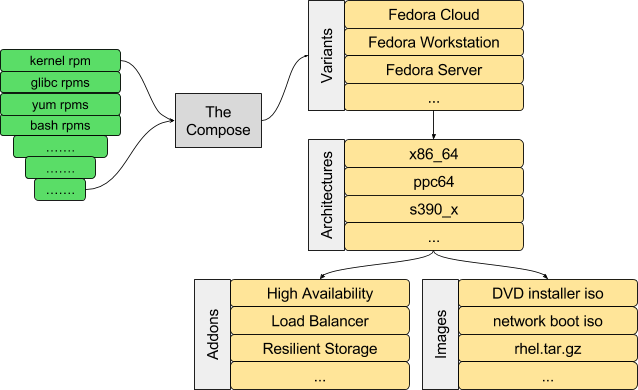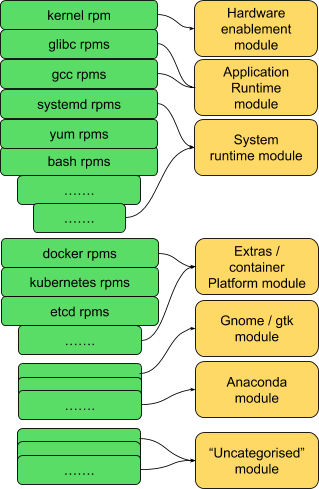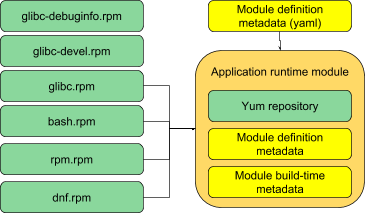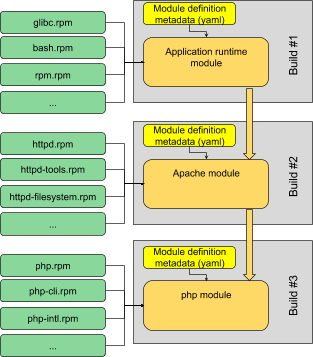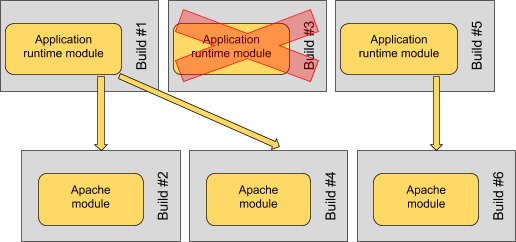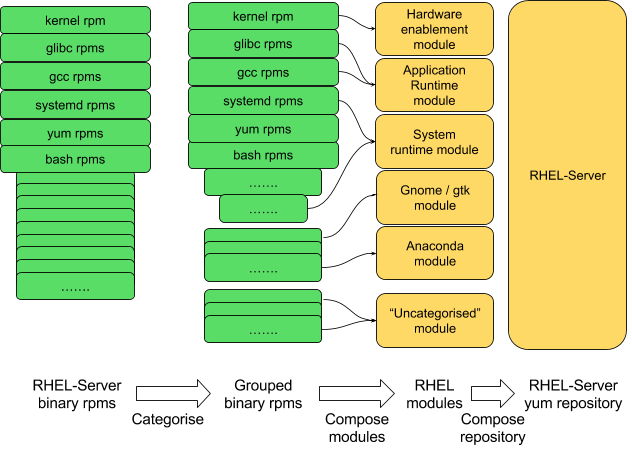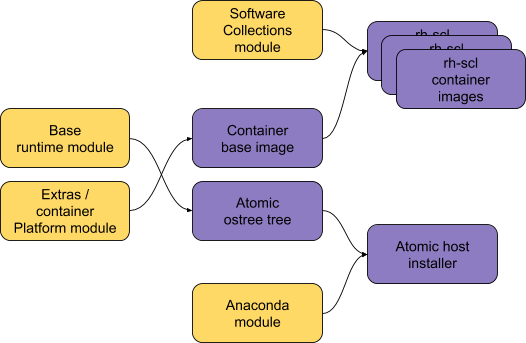m (→Summary) |
mNo edit summary |
||
| Line 14: | Line 14: | ||
Once we have parts of the distribution on different release cycles, we also have the issue of how to maintain different versions branching on different criteria and different schedules. Branching and versioning is relevant here, but is a complex topic in its own right and the topic of a future document. | Once we have parts of the distribution on different release cycles, we also have the issue of how to maintain different versions branching on different criteria and different schedules. Branching and versioning is relevant here, but is a complex topic in its own right and the topic of a future document. | ||
=== Constructing a modular distribution TOC === | |||
== Breaking down the monolithic release == | == Breaking down the monolithic release == | ||
Revision as of 14:34, 9 September 2016
How to break a release into meaningful chunks; and put it back together again!
Author: Stephen Tweedie
Summary
The fundamental objective of the Modularity effort is to break up the monolithic concept of a “distribution release” or traditional Compose into something more fine-grained. We should be able to release applications or stacks such as LAMP or ruby-on-rails on a lifecycle that suits the application, rather than being dictated by the distribution release schedule; and we should be able to compose releases more flexibly from the various components available.
But modularity is unlikely to succeed if it requires both users and maintainers to immediately and completely discard the existing concept of Releases and Editions of Fedora. So in this document we look at how to break the traditional distribution down into a modular construction, while still preserving the ability to build the traditional releases.
This document does not try to explore how we should organise a distribution release in detail. Exact lifecycles for kernel vs. applications, for containers vs. baremetal etc. are beyond the scope here; indeed, our objective is explicitly not to assume what we need in a release, but rather to add flexibility so we can change release objectives later on. If we want Fedora Server to have a longer lifecycle than Workstation; or for Atomic to rebase docker more rapidly than Server; or for a new python to be released outside the normal distribution cycle; all these things may be possible if we have a more flexible underlying release structure. The flexibility is the subject here; planning the actual releases is a different topic.
But, ultimately we still need the well-defined concept of a release, so that all the modules we are maintaining can still come together into a well-tested, planned release on a known schedule. We also define and justify a static manifest to assign packages to modules.
Once we have parts of the distribution on different release cycles, we also have the issue of how to maintain different versions branching on different criteria and different schedules. Branching and versioning is relevant here, but is a complex topic in its own right and the topic of a future document.
Constructing a modular distribution TOC
Breaking down the monolithic release
We have many steps in the release pipeline today: starting with bugzilla and dist-git; building and tagging in brew; the errata tool and CDN for pushing the bits out.
But currently it all comes together in The Compose.
Remember, I’m not talking about branching and versioning in this particular document. So let’s start with the assumption that we’ve already built our individual packages, and that (for now) we have a flat namespace of binary rpms already built from all our components. That namespace could be living in a yum repository like the rawhide repo, or a brew/koji tag such as fedora-24.0-candidate.
We build all of the images and repositories, for all of the architectures and their addons, for all of the variants, all at once. Fedora’s Editions have a similar structure.
This served us well once upon a time. It enabled a single consistent major or minor release, and it built everything necessary for that release.
But it now falls short on multiple fronts:
- We have many more types of artifacts being built than are handled by the compose. We have ostree trees and installer images; there are cloud targets such as qcow images and AMIs; and docker base and layered images. We have additional, often ad-hoc, incompletely-automated builds to create this additional content.
- The compose process does not represent all of our releases. An obvious example is the batched update errata delivery in Fedora 24, where we attempt to synchronise atomic and Fedora errata into a single predictable consolidated errata release. Yet the release tooling has no formal knowledge of that release.
- The modularity effort is explicitly trying to get away from the concept of a single monolithic distribution, and to release modular parts of the distribution on independent release cycles.
- Scaling: as we increase the number of modules, we do not want to spend the effort of rebuilding the entire distribution when any small part changes. For example, with more container images to build, we should be trying to rebuild only those affected by any change.
- Self-service: to scale the modular decomposition of the distribution, we will need the ability for individual engineers or groups who own a module or image to build that themselves, not dependent on release engineering.
- Continuous Integration. For automated testing, we want rebuilds to happen automatically when a dependency changes, instead of having to wait for a compose that happens on a predetermined schedule, or when manually triggered by release engineering.
So how can we address some of these concerns? We take the following steps:
- Break down the distribution compose into smaller parts:
- Ensure each part can be composed based on configuration and content in SCM. Everything must be recomposable based on static content: never, ever require manual configuration of a compose. That way composes can be automated;
- Combine the smaller composes up in stages building towards a full distribution;
- Record a compose ID for every stage of the compose, and record which compose IDs are used as input to subsequent layered composes
- Record the most recent successful compose for each module, so that failed composes (or composes that fail testing) do not impact layered modules
- Optionally, we can automate the process of chain composes and add CI to the mix to achieve a fully automatic build toolchain.
Incremental compose of the distribution
1. Break the distribution into distinct modules
Let’s take this in stages. We can start by simply assigning individual packages to modules (at the sub-package level: we may have a need to have a library in a base module but have its -devel subpackage in a developer-only module, for example.) This ignores the branching of packages and modules, but as stated before, that’s a separate topic.
Note: The module boundaries here are just examples. They are illustrations to show how we can break the monolithic distribution up. They are not proposals that we should draw the lines between modules in any particular places: that is an entirely separate discussion.
We can start with some obvious “core” modules such as hardware enablement, system runtime and core application runtime.
The installer needs GTK and Anaconda; let’s make sure we have homes for those.
This leaves a lot of content currently not assigned to a module. That’s fine, we can figure out how to handle those; for example, we could choose to define a module for “uncategorised” for now, and another for those packages currently in Optional.
All we have done so far is to draw boundaries around groups of existing packages:
We can add Apache, php and mariadb, and we could have the components of a LAMP stack, etc; there are plenty more groups we can imagine here.
Note: This picture shows a static allocation of packages to modules. So, modules have a static manifest. This is deliberate:
If, over time, a package in a module picks up a new dependency, then it should be a human decision to determine which module that new dependency should live in (or even whether we want that dependency at all.) This allows us to combat dependency sprawl over time, and also to record why a particular package lives in a particular module, at the time we add a dependency.
To enable an engineer to manually allocate new dependencies to modules, it it necessary that module manifests should not just be automatically generated. We consider that manifest to be one of the defining properties of the module.
2. Automate the composing of modules from packages
We now want to compose a module. Bear in mind, “composing” the module here involves assembling pre-existing binaries: it’s more a “createrepo” than “rpmbuild” (and is similar to a “puddle” build in current RCM terms.) And the automation we’re talking about here is the execution of the module compose, even if the compose is actually triggered manually.
A module compose is now simply the creation of a yum repository of the required packages or subpackages, with the addition of a small amount of module metadata as described in Building modular things.
We plan the module definition metadata living in dist-git, similarly to how we currently maintain component spec files, sources definitions and patches. Regardless of where it lives, the module compose must be well-defined based on static content. The essence of an automated build system is that when a compose is required, there should be no compose-time configuration added; everything to compose the module is stored in SCM and should be completely repeatable from there.
This workflow mirrors existing practice for building binaries, where a developer expects to be able to build and test an rpm locally for a single architecture, before submitting to the build system to be built on multiple architectures. In the same way, we would expect the build-system module compose tool to pull together the necessary packages and to create arch-specific modules for each required architecture.
We mentioned before that we expect modules to have a static manifest. During module compose, however, we would still expect to perform repoclosure on the module: ie. to verify that the module satisfies the dependency requirements of all packages it includes. Failure of repoclosure should constitute a failed compose of the module. The tooling may still attempt to solve missing dependencies automatically, but should only report to the user which packages could be included to satisfy those dependencies; it should not include those in the output without confirmation from the module owner.
To automate module composes it will be vital to know exactly which version of which packages should be used to compose any given module (eg. for brew builds, this would be selected by brew tag.) The important point is that all of this should be configured in the module metadata so that we can compose the entire module automatically.
3. Automate the composing of stacks from modules
Recall that a stack is nothing more than a module that depends on other modules; the stack simply refers to that whole tree of dependencies.
So composing a stack requires nothing more than composing a module that has dependencies. We define that top-level module via a metadata file in dist-git just as for any other module. The required dependent modules are listed in the module’s defining metadata. This is important: just as for a compose of an independent module, the entire module compose is well-defined based on static content.
The only difference in the compose of such a higher-level module is in the checking of internal rpm dependencies: both the repoclosure test, and any hinting done to suggest missing packages, should be performed on all packages in the entire stack, including all of the packages from other modules that this module depends on.
Of course, we may be composing a module multiple times. And to manage consistency between modules when things are changing, we really need to be able to determine exactly which version of a module has been composed from exactly which versions of its dependencies. So each module compose must have a unique compose identifier of some form; and during a layered module compose, we must record the compose IDs of all the modules used as input for this compose.
So to compose a PHP-on-Apache stack we might simply compose the base runtime module, then a layered Apache module, and finally a php module on top, in that order:
4. Automate the composing of images and other artifacts
So, now we’ve got enough modules to represent entire stacks of content suitable for installation to solve some user problem. But still, these are no more than repositories of available content; we still need to actually install them to use them.
Sometimes the user will install them themselves; the module client can automate the complete installation of an entire stack of dependent modules seamlessly.
But sometimes we’ll want to pre-install the content into some other artifact: a container image, an installer iso, or an ostree tree, for subsequent delivery to the user. That’s fine, we can drive whatever tools we need to build these artifacts. The only principles we rely on are the ones we’ve already mentioned:
- We need to compose the images from static configuration/manifests: no manual invocation of builds with magic command line parameters, the tools should be able to find all the configuration/input they need from SCM etc.
- Record compose IDs of everything we consume as input, and generate a build ID from the output;
- Each compose produces just one artifact (or as few as possible); no monolithic composes that try to build massive amounts of the distro in a single step. We end up with the same traceability because the composes can all use the same exact inputs guaranteeing the artifacts are the same except for their distribution packaging.
5. What happens when a compose fails?
One problem with a monolithic compose is that a single problem can fail the entire compose.
How do we prevent a similar situation where a broken compose of a base runtime module causes compose failures for all other modules depending on it?
Having a granular compose process actually improves this situation significantly. We simply need to remember the most recent successful compose for any given module, and use that compose for any subsequent layered composes.
So composing modules here from left to right still works fine; the failed compose #3 of our base runtime module does not prevent a subsequent compose #4 of the Apache module from succeeding; that compose simply picks up the most recent successful compose of the base runtime. And when a new compose of the base runtime does eventually succeed, then it becomes available to future composes of the Apache module on top.
6. Chaining recomposes
So far we have talked about “composing” a module in terms of re-running the creation of that module from its component parts (the packages it contains, and the metadata belonging to the module) on demand. When a module compose is requested, the build system must have enough information to complete that compose on its own, but the build system does not necessarily know itself when to compose a module.
But of course, we can automate that part too. Just as a CI package workflow might want to rebuild and retest an rpm when a dist-git event occurs, we want to be able to recompose both modules and artifacts whenever their content changes.
The details of each individual task here are not important; indeed, it is important to include many different types of task in this automation. Recomposing a module may be triggered by an rpm rebuild; that recompose may trigger other module recomposes, and additionally may trigger other image rebuilds. We may add CI to the mix so that testing tasks are also triggered when appropriate.
What is important is that the chaining of tasks is automatic. When something changes in the content tree, the build system must know (or be able to tell us) what else needs to be rebuilt or recomposed as a consequence; it must have the information needed to perform those rebuilds without additional manual configuration; and it should have the ability to trigger those rebuilds automatically subject to rel-eng policy.
Which leads us to:
7. The Release Concept
A CI / chain-build toolchain is fundamentally asynchronous. Content is rebuilt, recomposed or re-tested when its dependencies change. This is deliberate: a modular release is, by definition, attempting to break up the monolithic, synchronous Compose.
But ultimately, engineering still wants to be able to produce a planned release spanning many modules, and users still want to have controlled, predictable releases, rather than having modules dribble into a release in drips. We still have major release events such as Fedora major/minor updates, and we have been going further in this direction recently for errata with the advent of consolidated batched updates in Fedora 24 z-stream. Atomic Host updates need a coordinated release of base Fedora updates plus container enablement from -Extras; and a new release of Software Collections involves the synchronised release of many individual stacks.
So decomposing the release into loosely-coupled compose steps is all well enough, but we need more than just chain rebuilds to bring it all back together. We need to know what modules need to come together on what date to make a given release.
So we introduce the formal concept of a release as a concept that defines requirements across multiple modules. The release would define, for example:
- Which modules are included in the release (and, if those modules have multiple versions available, which versions come together for this release);
- The date scheduled for the release;
- Minimum SLA and lifecycle expectations for the release, so that we can verify during planning that all the required modules and all their dependencies have the required support
This information cannot be inferred from the individual modules comprising a release. The reason is simple: it’s a primary assumption in modularity that any one module may be included in multiple products and/or multiple releases.
Furthermore, there is a chicken-and-egg situation involving build-system automation of modules. If module definitions live in dist-git, then how does a build system know which dist-git repositories to look up to know what builds need to be performed automatically? The release is a natural place to define that.
Note: Technically, a release could easily be encoded as yet another dist-git module itself, one with many dependencies and no additional content of its own. It could be similar to an rpm meta-package in this regard. But it is still a distinct concept.
Putting it all back together
We need the flexibility of a smaller, more modular distribution that can be reassembled in various different fashions. But we also need to be able to reproduce our current product lineup, or something very similar, in order not to disrupt our existing install base:
Example: Reproducing the traditional distribution versions
Having categorised the Fedora rpms into groups and composed those package groups into distinct modules, creating what we have traditionally called a distribution variant can now be done simply by creating a flat yum repository containing all the desired modules for that offering. In the terminology we are using here, the output repository is simply another output artifact.
And of course we can repeat this for different Fedora variants. Having separate GTK and Gnome modules would allow us to include those modules when composing the Fedora Workstation repository, but omit those from the Client Node variant if we chose. It would also give us a natural way to reflect that Gnome may rebase at a different cadence from the base runtime.
So today’s variants can simply become different ways of selecting from the available modules.
The installer iso can also be composed from the various modules here, as a separate output artifact. The main difference from the traditional monolithic Compose is that the repositories, images etc. that are composed today are still composed, but each is created as a logically separate build.
Add-ons are not drawn above. An add-on is almost completely synonymous with a module here, and the modules composed as above can naturally reflect the composition of add-ons.
Example: Creating atomic host/container images
A key point of a broken-down, asynchronous build toolchain is that we can create composes from different modules with different SLAs or lifecycles, and can combine both modules and existing artifacts into yet further artifacts.
For example, we can define a tree of required artifact builds for Atomic Host and our Docker container images (each purple box here represents a distinct artifact created by a distinct compose task):
The Fedora-Server base system and Extras today already have distinct SLAs and lifecycles. We already build atomic host trees out of both of those sources, and this can be done easily as a compose step based on the base runtime and container platform modules in a modular build of the same components.
But we also need to support layered builds, such as additional container images layered on top of the base image, or Anaconda installs of an existing ostree tree. As long as we can track which compose steps are used as input to each compose task, we can track the relationship between these output artifacts even when we have decomposed the monolithic Compose into many parts.

